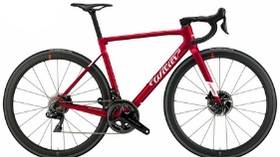If you are looking at road bikes, you might be wondering whether they come with pedals, and if not, why not?
Bikes are expensive and many people have to shop around quite a lot before they find the perfect bike for them – and while shopping around, you will probably notice that many bikes do not have pedals on them.
If you have ever seen bikes without pedals, you might be a bit puzzled by them.
Why would a bike not have any pedals? Do you choose your own pedals at a later date? Is there a reason they are missing?
Generally, most road bikes don’t come with pedals because people prefer to choose pedals that fit their shoes and cleats. Adding pedals to the bike separately makes it easy to tailor the bike to your specifications because you might want clipless, flat pedals or toe clip pedals.
Road bikes usually don’t come with pedals unless they are very low-end bikes or children’s bikes because cyclists generally prefer to use their pedals so that they can match pedals to shoes.
It allows for more flexibility in cycling, reduces the need for the cyclist to keep changing their shoes, and makes it easier for cyclists to choose which attachment method they prefer.
Table of Contents
Why Don’t Road Bikes Come With Pedals?
If you are a new cyclist, you might be wondering why on Earth road bikes would come without pedals, but this is due to the individual preferences of each cyclist and allows cyclists to pair their new bike with their existing shoes.
Most cyclists don’t want to replace their shoes every time they change their bike; a good pair of shoes makes a lot of difference to the enjoyment of riding.
From both a manufacturing perspective and the buyer’s aspect, it makes more sense for cyclists to add their own pedals later, as this is easy to do and gives them added flexibility.
It might seem that bike pedals should just match the shoes using a standard clip, but this isn’t so in many cases.
There are multiple different standards for high-end bikes, and cyclists would need many pairs of shoes to match all the different models instead of having a single pair to use with the pedals.
So, why do low-end models not have this problem?
Why can manufacturers put pedals on these?
It’s because most low-end bikes use a standard simple toe clip that will latch onto a cyclist’s shoes regardless of what kind of shoes they wear.
So, low-end bikes can come with pedals, but they haven’t specialised the way that the pedals of high-end bikes are. They don’t allow certain manoeuvres to be done, and they make pedalling less efficient.
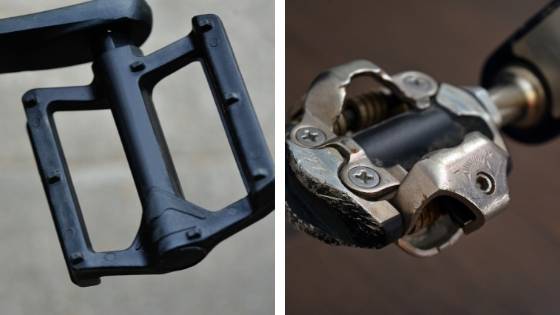
Clipless Peadles Vs Flat Pedals
Another reason that road bikes don’t come with pedals as standard is the cyclist ability and experience levels with using clipless pedals. Many people struggle with clipping their feet into pedals, particularly if they are new to cycling.
Therefore having a bike without pedals means the cyclist can choose a flat pedal. That way they can cycle the bike using the flat pedal and build up their confidence and abilities.
Once they have gained the experience of riding the road bike on the road, it might be time for them to move up to a pair of clipless pedals. This gives the bike the versatility to swap out pedals when they deem it necessary to use them.
Some of the high end and clipless pedals are both easier to use (in that you do not have to clip the shoes to the pedals) and they provide cyclists with more power and efficiency while on the roads.
If you don’t want to have lots of pairs of cycling shoes, it’s best to have pedals that are compatible with the shoes you currently own or choose a pedal that you like and buy a pair of shoes to match.
Do Road Bikes Come With Pedals?
Typically, road bikes don’t usually come with pedals, and even if you buy a second-hand bike, you might find that the owner has removed the pedals prior to selling it.
Cyclists tend to get attached to pedals and usually prefer to use their specific ones, so don’t be surprised if you find a road bike being advertised with no pedals attached to it.
Think about your road bike pedals and shoes as a pair. Unless they are selling their shoes with the bike, then the pedals are no use.
Cheaper road bikes may come with pedals, and if you buy a second-hand bike, you might find that the seller does not bother to remove the pedals.
But often, if you are an enthusiastic cyclist and you are buying from a different cyclist, you’ll find that pedals are not included, and you need to buy your own!
If you are a dedicated cyclist, you might find that you prefer to buy your pedals anyway.
Do New Road Bikes Come With Pedals?
It might seem strange to buy a brand new bike without something that is absolutely crucial to the operation of that bike, but often, new road bikes will be free from pedals.
The attachment points are there, but you have to choose and add the pedals yourself.
You may be able to buy pedals from the retailer that you buy the bike from, or you might find a different retailer. You might also have pedals yourself already which can be fitted to the bike. Any of these options should work.
Some low-end road and children’s bikes come with the pedals attached, but this is not often.
Top 3 Recommended Pedals
1. SHIMANO Ultegra R8000 SPD-SL XL Axle Carbon Road Pedal
- Ultegra performance – pro-level performance for the enthusiastic road rider.
- Lightweight – yet robust design, weighs only 248 grams.
- Extra-wide platform – wide platform delivers efficient power transfer and stability
- Integrated contact surface – durable integrated stainless body plate reduces weight; flex, and wear
- Wide bearing stability – wide bearing placement for stable and uniform load distribution

I really like the extra width since pedal because I have wider feet. They are spaced out from the crankshaft, so the sides of my shoes don’t rub onto the shaft, which happens from time to time. Furthermore, they are effortless to clip in and out of.
2. ROCKBROS Bike Pedal CNC
- LIGHTER BUT STRONGER: aluminium alloy body, high-quality pedals in weight of 196g/pc, much lighter and more robust than those other Aluminum Alloy Injection Ones
- EXCELLENT DESIGN: ideal for big size feet, comfort& pedalling efficiency with a good skid resistance design for a long ride
- 3 SEALED BEARINGS: 3 pcs sealed bearings keep the elements out and contribute to long-lasting, smooth-rolling pedals
- GOOD PERFORMANCE: Durability standard, replaceable pins, enhanced stability surface has the traits of comfort and good anti-slip performance
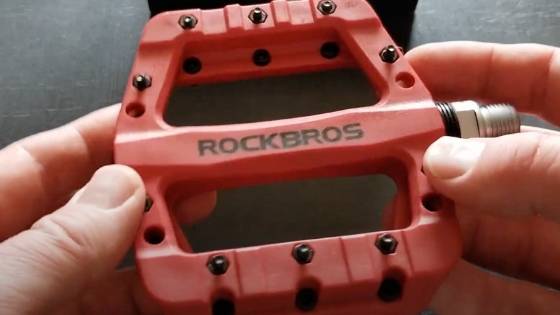
These are not for heavy off-road rides but are more designed for road bikes and easy mountain biking. These pedals give me much more stability because they are wider and easy to place my foot on. There’s no need for straps or clips as they have small grips on the pedal that grip your shoe.
3. SHIMANO PD-M540 SPD Pedals
- Fluorine-coated binding claws allow for easy entry and release
- Pedals are dual-sided for easy access and feature solid and durable spindles with 8mm Allen wrench mounts
- Low-maintenance sealed bearing cartridge axles
- Sealed cartridge bearing spindle keeps out water and mud for a smooth action and makes for a durable pedal
- Open design helps to shed mud
- Weight: 380 grams per pair
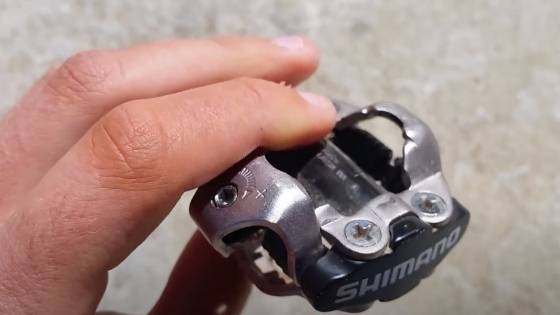
The two-sided clipping makes it easy to clip your feet in and out, especially if you’re new to clipless pedals but clip out early to give yourself time. Not just made for mountain bikes but can be a great introduction to clipless pedals for any bike.
Do Mountain Bike Pedals Fit Road Bikes?
Typically, road bike pedals and mountain bike pedals are universal and can be fitted to either bike. The threat size (9/16″ x 20) is the same on both bikes. Therefore you won’t damage the pedals.
That means if you have a favourite kind of pedal on one bike, there is no issue with transferring it over to the other bike for a day – or longer.
Nonetheless, it is vital to check that the pedals are compatible, as some low-end pedals are made with different thread sizes and may not fit universally across bikes.
When you are looking to buy pedals, make sure that you have read the packaging carefully.
You should also be aware that they often use different clip systems, and you will either need to buy special mountain bike shoes or an adapter that allows you to use road bike cycling shoes with a mountain bike fitting.
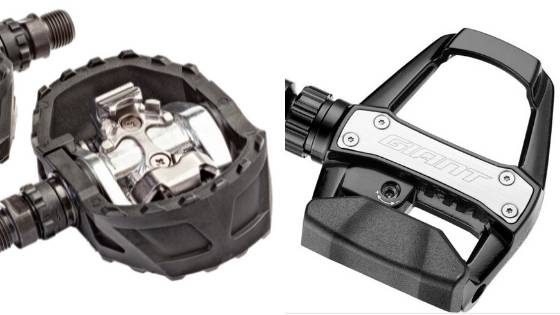
What’s the Difference Between A Road Bike Pedal And A Mountain Bike Pedal?
The difference between a road bike pedal and a mountain bike pedal is minimal but can make a massive difference to the feel of the ride.
Typically, road bike pedals can only be clipped on one side, making it harder to clip your foot onto the pedal. However, road bike pedals are lighter than mountain bike pedals and are slightly smaller in size and diameter.
As for the mountain bike pedal, they can be clipped onto both sides of the pedal, making it far easier to clip your shoe and cleats into the pedal.
It makes it ideal for beginners who aren’t accustomed to clipping in and out of pedals on the road bike.
Mountain bike pedals are designed to clip in and out faster because there is a higher risk of falling off the bike when off the road.
Finally, the last piece of the pedal to examine is the cleats.
Typically road bike cleats are manufactured of lightweight plastic and mountain bike cleats from metal. Therefore if you’re walking around in your cycling shoes, the plastic cleat on a road bike style pedal will break far easier than on a mountain bike cleat.
The cleats are different because the plastic road bike cleat is lighter weight than a metal mountain bike cleat. Mountain bike cleats are designed for you to put your foot down more often because of the style of riding.
Suggesting if you notice you put your feet down a lot more or you want to walk around in your cycling shoes, then a metal cleat with a mountain bike pedal will be far better on your road bike.
